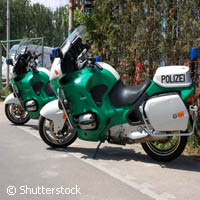EU project offers helping hand to overloaded police officers
European communication companies, research institutions and police forces have come together to help police motorcycle officers carry out their work more safely, efficiently and effectively by offering them a new way of processing information and responding to demands. The MOVEON ('Multi-modal and multi-sensor zero-distraction interaction interface for two wheel vehicles ON the move') project received nearly EUR 2 million from the 'Information society technologies ' (IST) Thematic area of the Sixth Framework Programme (FP6). A motorcycle police officer on an urgent call faces huge information processing and decision-making demands. A research project led by members of the private and public sectors from across the EU, including Microtech International in Poland, the West Midlands Police in the UK, Thales Communications in France, and the University of Patras in Greece, aims to prevent potentially dangerous information overload using state-of-the-art technology. 'Because of the limitations of the devices they carry with them today, officers often don't perform to the maximum,' said Dr Elias Kalapanidas, Technical Manager for the MOVEON project from the Electrical and Computer Engineering Department at the University of Patras. 'The project set out to make ordinary operational procedures, like changing a communication channel, quicker and easier, and to maximise the information that an officer can send and receive without being distracted or having to stop the motorcycle,' he explained. Based on a thorough examination of real-life conditions and on requirements identified by police officers, Italian automotive engineering company Pininfarina designed a special-purpose helmet that was virtually tested by computational fluid dynamics (CFD) analysis. A MOVEON prototype has already been field tested in the UK and Dr Kalapanidas is now working with the consortium's other commercial partners to develop products for use worldwide, not just by police organisations but also by fire-fighters and other emergency services. The MOVEON partners realised that simply funnelling more information to motorcycle officers - for example via a heads-up GPS (global positioning system) display or a sleeve-mounted touch screen - might not help them manage their missions more efficiently, and that information relayed at the wrong moment could create a dangerous distraction or overload the officer. In response, they created the MOVEON processor that combines biometric information with officers' recent interactions and with data about driving conditions such as speed, acceleration, the tilt of the motorcycle and proximity to an intersection. 'We have developed an algorithm that sums up all that information, estimates the overall cognitive load on the driver and the demands being placed on the visual, acoustic and tactile channels,' explained Dr Kalapanidas. 'Based on that, we can select the best channel available at that time.' Moreover, if the system decides that any further information would overload the officer, it temporarily stops the communication. 'When the load settles back below the threshold, the information flow starts up again,' he said. A speeding motorcycle is a notoriously noisy environment and so the researchers were compelled to develop an enhanced speech recognition system that could identify an officer's voice commands amid a welter of noise. 'Our requirements were not for a huge vocabulary, but for a very robust speech recognition algorithm, one that could extract speech from the many noises coming from the environment and the motorcycle,' noted Dr Kalapanidas. Moreover, knowing that there would still be situations when voice commands would not work, the researchers provided officers with an independent control mode through touch. Officers can manage the MOVEON system through a joystick mounted on the motorcycle handlebar and through a touch screen built into the sleeve of their jacket. 'These devices complement each other and allow us to achieve a very robust command input,' Dr Kalapanidas concluded.
Countries
Greece, United Kingdom

